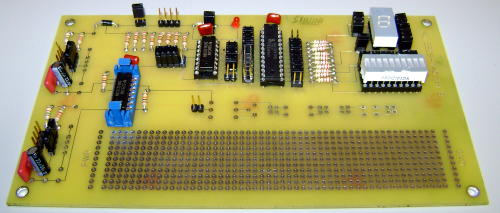EECS 140 Lab
From ITTC
Contents
Announcements
- No labs during first week of classes.
- Labs start from 01/27/20
Lab Information
All labs for Fall 2019 start on Tuesday Jan 27th, 2020.
Location: 2010 Eaton Hall
* Monday : 08:00 - 09:50 AM - Pramil * Tuesday : 08:00 - 09:50 AM - Sharmila * Tuesday : 10:00 - 11:50 AM - Kishanram Kaje * Tuesday : 12:30 - 02:20 PM - Kishanram Kaje * Wednesday : 08:00 - 09:50 AM - Lazarus * Wednesday : 11:00 - 12:50 PM - Sharmila * Thursday : 08:00 - 09:50 AM - Pramil * Thursday : 10:00 - 11:50 AM - Amin * Thursday : 12:30 - 02:20 PM - Amin * Friday : 08:00 - 09:50 AM - Lazarus
Graduate Teaching Assistant(s)
- Kishanram Kaje, kaje@ku.edu
- Office - Eaton 2010/3029 (Email beforehand)
- Office Hours - Tu - 02:20 PM-04:20 PM
- Lazarus Francis S, sflazarus@ku.edu
- Office - Eaton 2010/2029 (Email beforehand)
- Office Hours - W 10:00 to 11:00 AM and F 10:00 to 11:00 AM
- Amin Shojaei, amin.shojaei@ku.edu
- Office - Eaton 2010/3029 (Email beforehand)
- Office Hours - F 09:00 to 11:00 AM
- Pramil Paudel, pramil.paudel@ku.edu
- Office - Eaton 2010/3029 (Email beforehand)
- Office Hours - M 10:00 to 11:00 AM and Th 10:00 to 11:00 AM
- Sharmila Raisa, sharmila@ku.edu
- Office - Eaton 2010/3006 (Email beforehand)
- Office Hours - Tu - 10:00 AM-12:00 PM
- Note: Please include [EECS 140] and your session in the subject line when you email your GTA.
Course Instructor(s)
- Dr. David Petr, dwp@ku.edu
- Office Hours - TR 11:30 to 12:30 PM and W 1:30 to 2:30PM
- Dr. David Johnson, davidojohnson@ku.edu
- Office Hours - M 01:00 to 3:00 PM and F 8:45-10:45 AM
Lab Report Format
- The lab report format is a simplified version of the lab report formats that you will use for the rest of your educational (and professional) engineering career.
- Use the template provided in the handout by your GTA when writing your lab reports. All sections are clearly defined for your convenience.
- The template is for reference for minimum requirements on a Lab report. You'll need to explain your work clearly along with your contributions in the lab plus whatever requirements mentioned by GTA.
Lab Schedule
VHDL in Vivado Labs
- This [Introduction to Vivado Tutorial] will teach you how to use Vivado.
- This VHDL tutorial will teach about the VHDL language, its fundamentals, and how to represent a simple circuit in VHDL.
- This Modular VHDL tutorial will teach about the using components in VHDL, and creating larger entities by structural design.
- This Digilent FPGA Board Basys 3™ FPGA Board will be used in the lab.
- Digital Design Using Digilent FPGA Boards: VHDL/ Active-HDL Edition by Richard E. Haskell and Darrin M. Hanna
Lab 1: Introduction FPGA Programming with Vivado
- Become familiar with Vivado and apply it to program a simple AND gate on your Basys-3 FPGA board
Lab 2: Introduction to VHDL
- Learn the basics about modern programmable logic and become familiar with Vivado and Adept software
Lab 3: Implementation of nuclear power plant control circuit
- Use VHDL to design the nuclear power plant control circuit and implement this design on Basys3 board
Printed Circuit Boards (PCB) Labs
Lab 4: Introduction to prototype board
- Solder power circuit, input switch circuit, output LED circuit and perform initial board test
Lab 5: Implementing a SOP Expression on Prototyping board
- Solder IC sockets, bypass capacitors, power and ground buses and interconnections headers.
VHDL + FPGA Labs
Lab 6: 7-Segment Display
- Create a seven segment display driver.
Lab 7: Introduction to Structural VHDL models
- Learn basics of structural VHDL models and design simple circuits using structural VHDL.
Lab 8: Four Bit Adder with Double 7-Segment Display
- Create a binary 4-bit adder and display the result on two 7-segment displays. Learn about VHDL code modularization.
Lab 9: Arithmetic Logic Unit
- Add multiple operations to our circuit. Allow the selection of operations, while still using the 7-segment outputs and a multiplier.
Lab 10: Scrolling Display
- Use modular VHDL to display a scrolling phrase on the FPGA.
Lab 11: Decoder and Encoder
- Implementation of Decoder and Encoder.
Lab 12: Latches, Flip-flops, and Registers
- Investigate latches, flip-flops, and registers.
Resources
This class will focus on using the Altera Flex 10K-UP2 Board along with the associated Altera Max+plus II software.
- EECS Shop
- Resistor Color Code
- Resistor Calculator
- Facebook Group: I Hate VHDL!!!!
- Capacitor Coding
